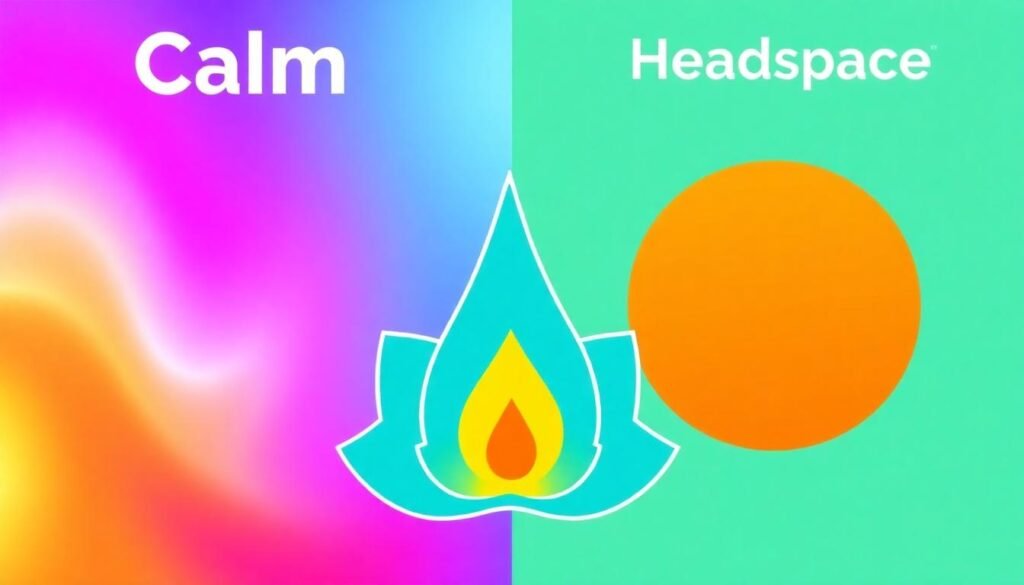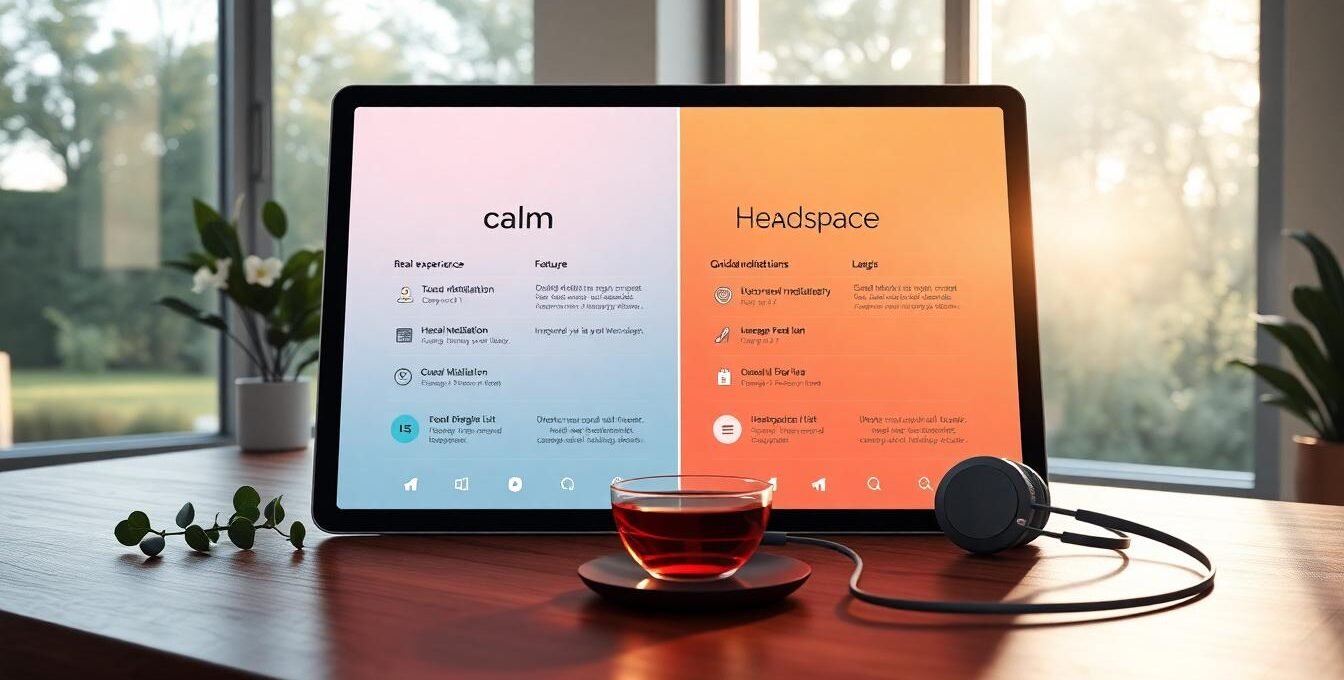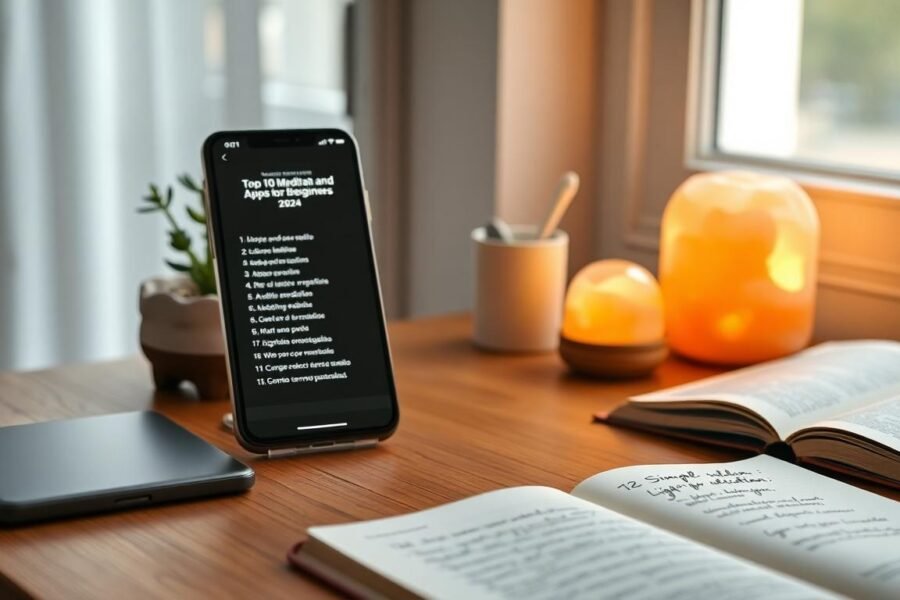The search for peaceful moments has never been more popular. Calm and Headspace have gained millions of users worldwide, bringing meditation into the daily lives of people with busy schedules, insomnia, or a desire to slow down. Each app has its own way of helping: Calm focuses on relaxation with sleep stories and soothing tracks, while Headspace offers a clear, organized, guided method—ideal for those who want structure.
The right choice makes a difference in both experience and results. I’ll show how each app can fit into your daily life and reveal practical details that help you decide. After all, there’s no one-size-fits-all best solution—only the best for each person. Want to find the app that fits your life? Come with me through this direct and honest comparison.
User Experience: Visuals, Navigation, and Sound Atmosphere

The way a meditation app presents itself makes all the difference for everyday use. The design, navigation, sounds, and even colors set the mood and help with either relaxing or learning. Calm and Headspace take very different approaches. One invites comfort and tranquility right away, while the other bets on simplicity, clarity, and visual logic. I’ll break down how each one builds its sensory experience and what stands out most.
Calm: Sensory Relaxation and Peaceful Sleep
Using Calm is like entering your own private sanctuary. As soon as I open the app, I see serene landscapes—forests, lakes, even soft rain—always paired with sounds of water or rustling leaves. The background is never static. The screen feels light, with soft colors that shift depending on the selected track.
Calm stands out by using immersive soundtracks, narrated stories, and natural environments to transform the user’s mental space:
- Relaxing tracks: Choose from nature sounds, soft instrumental music, or ambient noises like a fireplace or forest scent. Each is carefully designed to reduce stress and quiet the mind.
- Sleep stories: These narrated tales use calm, pleasant voices with background sounds to help your brain slow down—perfect for those who struggle to fall asleep.
- Immersive environments: Everything is sensorially engaging—even transitions between screens are subtle. There’s no rush. The focus is on the journey, not just the goal.
Calm invests in sensory experiences that feel like a hug for the soul. It’s not just about listening to relaxing music—it’s about entering a whole different world, where even the interface flows at the pace of your breath. For those looking to disconnect from the world, it’s like closing your eyes and drifting into another dimension.
Headspace: Structure for Learning and Building Habits
Headspace bets on visual clarity and practical organization. The first thing you notice is its simple, direct, and easy interface: white background, colorful characters, and cheerful minimalist illustrations. Everything feels designed to avoid distractions and make focusing easier.
This app builds its experience through a didactic structure:
- Guided journeys: Instead of just offering relaxing sounds, Headspace organizes content into series and modules. Each “course” has a beginning, middle, and end. It’s ideal for those who like tracking progress and understanding how each step contributes to growth.
- Educational animations: Many sessions include short videos or illustrations that explain techniques. These playful animations make concepts like mindfulness and breathing easy to grasp, even for beginners.
- Fast, intuitive navigation: The side menu makes it easy to find topics like sleep, focus, stress relief, or guided meditation. Everything is categorized by goal, and the search is quick.
In Headspace, the background audio plays a more discreet role. The ambient sounds are soft and steady, never overpowering the guide’s voice. The app aims to teach one step at a time, like a patient friend leading you gently forward. For those who like structured tracks and a more educational approach, it feels like home.
Both apps prove that environment, sound, and visual design matter. With Calm, I feel deeply relaxed and even introspective. Headspace, on the other hand, motivates me to build a consistent routine and grow my knowledge, with no mystery involved. The best choice depends on which type of sensory experience fits your lifestyle better.
Functionalities, Programs, and Personalization

The details make all the difference when choosing your meditation app. Calm and Headspace go beyond the basics—they offer a universe of content, soundtracks, and experiences tailored to all user types, from beginners to longtime mindfulness practitioners. Personalizing the meditation moment is a vital part of the routine, and understanding what each platform offers could be the key to building a consistent habit. In this section, I compare library size, types of available content, the presence of experts and celebrities, and also touch on progress tracking and digital health integration.
Library and Exclusive Tracks: Calm Focuses on Stories, Headspace Shines with Courses
Opening Calm feels like flipping through a relaxation catalog: hundreds of guided meditations, calming soundtracks, relaxing music, and the famous “sleep stories.” These are bedtime stories, many narrated by celebrities like Matthew McConaughey, LeBron James, and even Camila Queiroz in the Brazilian version. This adds a special charm, as hearing a familiar voice guide you to sleep creates a unique connection. Tracks range from quick 3-minute sessions to longer ones over 30 minutes, focused on deep relaxation, anxiety, focus, or self-compassion.
Headspace, in contrast, creates a space for progressive learning.
It’s not just about variety—it’s about method. The app offers modular series and complete courses, ranging from beginner to advanced challenges. Each course has a specific focus, like anxiety, study focus, stress management, sleep, or emotional resilience. Modules are broken into short lessons (usually 5 to 20 minutes), allowing visible growth over time. Co-founder and former monk Andy Puddicombe is still present in many sessions, but Headspace now features big names too, like Olympic athletes, certified breathwork coaches, and psychology experts.
A quick summary of what sets each library apart:
Calm:
- Over 100 soundtracks, and hundreds of meditations on various themes
- Sleep stories narrated by celebrities
- Customizable tracks for relaxation, sleep, focus, gratitude, and more
- Kids’ sessions and nature soundscapes
Headspace:
- Structured courses for all levels, with themed modules
- Educational sessions with animations, visual explanations, and mascot guides
- Content produced by mindfulness experts, athletes, and psychologists
- Sleepcasts, soundscapes, breathing, and focus sessions
While Calm turns your phone into a kind of digital spa, focused on relaxation and exclusivity, Headspace feels like a mental fitness center—where every day you make progress toward your goals.
Progress Tracking and Digital Health Integration
Knowing how your practice evolves is important for motivation, especially during busy periods. Both Calm and Headspace include tracking features and stats that make the experience more personalized and effective.
In Calm, after each session, you see an immediate log of your meditation minutes, usage streaks, weekly stats, plus automatic reminders and digital trophies as you reach goals. You can track your history within the app and connect it to Apple Health, syncing meditation time, sleep logs, and even mood in some cases. Calm also allows you to customize reminders to ensure you don’t miss the ideal moment to relax—whether that’s before bed, upon waking, or during a break.
Headspace takes a more playful approach to tracking: you earn badges for records, complete weekly challenges, and get a visual summary of your progress at the end of each journey. When connected to Apple Health or Google Fit, your meditation minutes go straight to your wellness dashboard. This makes it easy to see meditation’s impact alongside other health data like steps, sleep, and mood. Headspace also sends personalized suggestions based on your usage—for example, it might suggest a short meditation during times it detects more anxiety or less engagement.
Key features that bring both apps closer to today’s digital user:
- Automatic logging of meditation minutes to track habit growth
- Daily and weekly streaks to maintain consistency
- Virtual trophies, badges, and milestones to keep motivation high
- Integration with Apple Health and Google Fit to visualize meditation’s broader health impact
- Custom reminders to fit meditation into your routine
Ultimately, these tools become allies in building the habit. Being able to visualize your progress, through either charts or small achievements, helps you stay focused. And syncing with health platforms expands this view, helping each person understand how self-care can be simple and natural.
Privacy, Security, and Cost-Benefit
When I think about a meditation app, I’m not just looking for relaxation. I need to trust that my information is safe. Plus, I always do the math—is it worth paying for more peace of mind? Time to take a closer look at privacy promises, how each app handles data, and what their pricing plans offer.
Privacy Policies: Where Is Your Data?
Privacy in meditation platforms goes far beyond the fine print. Calm and Headspace collect a good amount of data to personalize the experience, but each handles your privacy in its own way.
Headspace is ahead in transparency. The app has a “My Data” hub where I can see what info they store: name, email, usage data, IP-based location, mood tracking, and even in-app interactions. If I choose to leave, I can request deletion by email, and they promise full removal within 30 days. Headspace also clearly states that it doesn’t collect audio or access your device’s camera. For those worried about passive surveillance, that’s a relief.
Its data retention policy says tracking data and cookies are stored for up to one year, and any remaining personal data is anonymized or erased after two years of inactivity. One sensitive point: yes, some data is shared with partners like Google and Facebook for personalized ads. But I can opt out anytime, and the settings to do that are easy to find.
Calm also collects personal data, but navigating what’s recorded and how to delete it isn’t as intuitive. The company encrypts sensitive data like names and emails, but doesn’t clearly explain where it’s stored or how long it stays active after you request deletion. Calm shares data with research institutions, marketing brands, and ad platforms. While users can opt out of targeted marketing, there’s less clarity about how much control they truly have.
The process of deleting or editing data in Calm is far less user-friendly than in Headspace—there’s no central user dashboard. Everything depends on opening a support request and waiting for a response. In the end, it feels like control lies more with them than with me.
Keep in mind: both apps still face trust issues when it comes to mental health-related data. They comply with privacy laws like GDPR in Europe, but neither offers a fully secure solution to guarantee that your user history will remain 100% confidential.
To summarize:
Headspace: Data hub, quick deletion, clearer policies, easy user access—but still shares info for ads.
Calm: Similar data collection, but less transparency and fewer user-friendly options.
Both: Claim to follow protection laws, but sharing mental health data online always carries risks.
Pricing, Plans, and Free Trials
After privacy, I look at cost: what does it really take to make one of these apps part of my routine? Every penny counts—especially if I’m thinking long-term.
Headspace offers a straightforward structure:
- Free trial: 14 days with almost full access to test if it suits your style
- Annual plan: Around R$350 (US$70), one-time billing—more cost-effective for long-term use
- Monthly plan: About R$50—great for extended testing without long-term commitment
- Lifetime plan: Around R$2,000 (US$399.99) one-time fee—expensive, but ideal if you’re fully committed to the app
- Special discounts: Students and families get reduced prices with specific packages
Calm is similar in cost but has a shorter trial period:
- Free trial: Only 7 days—less time to explore for free
- Annual plan: Also around R$350 (US$70), with significant savings over monthly billing
- Monthly plan: About R$50—still less ideal than the yearly rate
- Lifetime plan: Calm charges roughly R$1,500 (US$299.99)—cheaper than Headspace, especially for long-term users
- Family plan: Add household members for a small extra fee—great for shared use
The impact of these options depends on your profile:
- If you want more time to test, Headspace’s 14-day trial might appeal more.
- For families, Calm’s wide variety of soundtracks and stories plus its family plan may work better.
- Lifetime access makes sense only if you truly plan to stick with the app for years. Calm’s lifetime option is more affordable than Headspace’s.
Both apps offer limited free content, but the full experience—courses, guided programs, sleep libraries, and self-discovery tools—is reserved for paying users. When comparing value, they’re evenly matched: Calm wins for those who love soothing tracks and a lower lifetime price, while Headspace offers a progressive learning system, ideal for those who appreciate clarity and structure.
In the end, the choice isn’t just about money—it’s about how much time you’ll dedicate to the practice and what kind of user you are: someone who wants deep calm through immersive sounds, or someone who thrives with a step-by-step system? Each subscription holds its own answer.
Conclusion
Both Calm and Headspace offer much more than simple guided meditations—they’re gateways to understanding your own rhythm and creating small self-care rituals. If you prefer to relax while listening to a gentle voice in the dark or immerse yourself in natural soundscapes, Calm delivers that sensory comfort. On the other hand, Headspace acts as a compass for your daily routine, with clear methods for those who want to learn techniques and build habits.
The secret lies in trying. I believe in the value of testing both—even if just for a few days. That experience shows, in practice, what truly fits your mind and schedule. Self-awareness becomes the key: only you can tell which app really aligns with your routine and your needs.
Choosing isn’t just about features and prices—it’s about allowing yourself to live the present moment in a way that only you understand. Meditation is a personal, unique journey. Thank you for following along this comparison, and I invite you to try, reflect, and share your impressions. The pause we’re all searching for may be found in the right app—but it truly begins when we look within.






Deixe um comentário